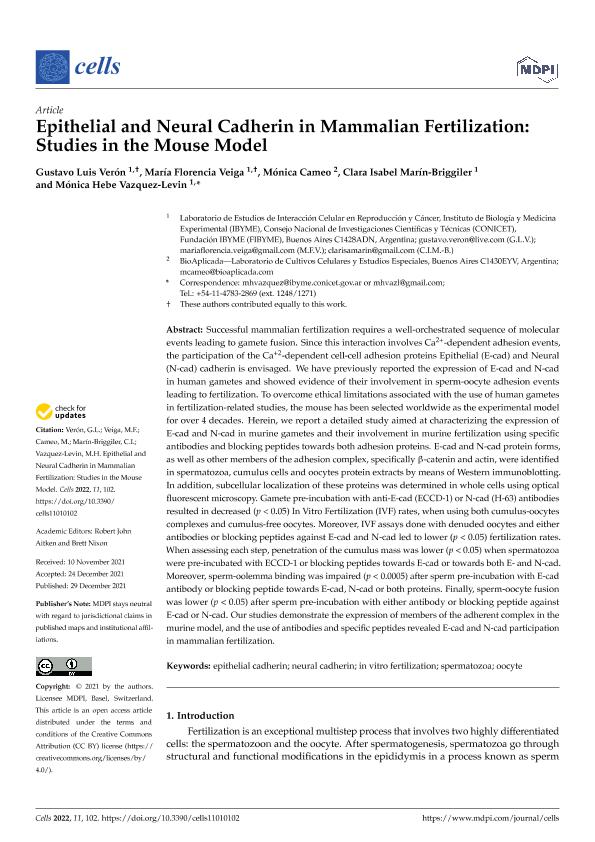Mostrar el registro sencillo del ítem
dc.contributor.author
Verón, Gustavo Luis

dc.contributor.author
Veiga, Maria Florencia

dc.contributor.author
Cameo, Mónica
dc.contributor.author
Marin Briggiler, Clara Isabel

dc.contributor.author
Vazquez, Monica Hebe

dc.date.available
2022-08-21T19:35:25Z
dc.date.issued
2022-01
dc.identifier.citation
Verón, Gustavo Luis; Veiga, Maria Florencia; Cameo, Mónica; Marin Briggiler, Clara Isabel; Vazquez, Monica Hebe; Epithelial and neural cadherin in mammalian fertilization: studies in the mouse model; Multidisciplinary Digital Publishing Institute; Cells; 11; 1; 1-2022; 1-20
dc.identifier.issn
2073-4409
dc.identifier.uri
http://hdl.handle.net/11336/166191
dc.description.abstract
Successful mammalian fertilization requires a well-orchestrated sequence of molecular events leading to gamete fusion. Since this interaction involves Ca2+-dependent adhesion events, the participation of the Ca+2-dependent cell-cell adhesion proteins Epithelial (E-cad) and Neural (N-cad) cadherin is envisaged. We have previously reported the expression of E-cad and N-cad in human gametes and showed evidence of their involvement in sperm-oocyte adhesion events leading to fertilization. To overcome ethical limitations associated with the use of human gametes in fertilization-related studies, the mouse has been selected worldwide as the experimental model for over 4 decades. Herein, we report a detailed study aimed at characterizing the expression of E-cad and N-cad in murine gametes and their involvement in murine fertilization using specific antibodies and blocking peptides towards both adhesion proteins. E-cad and N-cad protein forms, as well as other members of the adhesion complex, specifically β-catenin and actin, were identified in spermatozoa, cumulus cells and oocytes protein extracts by means of Western immunoblotting. In addition, subcellular localization of these proteins was determined in whole cells using optical fluorescent microscopy. Gamete pre-incubation with anti-E-cad (ECCD-1) or N-cad (H-63) antibodies resulted in decreased (p < 0.05) In Vitro Fertilization (IVF) rates, when using both cumulus-oocytes complexes and cumulus-free oocytes. Moreover, IVF assays done with denuded oocytes and either antibodies or blocking peptides against E-cad and N-cad led to lower (p < 0.05) fertilization rates. When assessing each step, penetration of the cumulus mass was lower (p < 0.05) when spermatozoa were pre-incubated with ECCD-1 or blocking peptides towards E-cad or towards both E- and N-cad. Moreover, sperm-oolemma binding was impaired (p < 0.0005) after sperm pre-incubation with E-cad antibody or blocking peptide towards E-cad, N-cad or both proteins. Finally, sperm-oocyte fusion was lower (p < 0.05) after sperm pre-incubation with either antibody or blocking peptide against E-cad or N-cad. Our studies demonstrate the expression of members of the adherent complex in the murine model, and the use of antibodies and specific peptides revealed E-cad and N-cad participation in mammalian fertilization.
dc.format
application/pdf
dc.language.iso
eng
dc.publisher
Multidisciplinary Digital Publishing Institute
dc.relation
https://ri.conicet.gov.ar/handle/11336/3156
dc.rights
info:eu-repo/semantics/openAccess
dc.rights.uri
https://creativecommons.org/licenses/by-nc-sa/2.5/ar/
dc.subject
EPITHELIAL CADHERIN
dc.subject
IN VITRO FERTILIZATION
dc.subject
NEURAL CADHERIN
dc.subject
OOCYTE
dc.subject
SPERMATOZOA
dc.subject.classification
Biología Reproductiva

dc.subject.classification
Ciencias Biológicas

dc.subject.classification
CIENCIAS NATURALES Y EXACTAS

dc.title
Epithelial and neural cadherin in mammalian fertilization: studies in the mouse model
dc.type
info:eu-repo/semantics/article
dc.type
info:ar-repo/semantics/artículo
dc.type
info:eu-repo/semantics/publishedVersion
dc.date.updated
2022-08-10T13:38:36Z
dc.identifier.eissn
2073-4409
dc.journal.volume
11
dc.journal.number
1
dc.journal.pagination
1-20
dc.journal.pais
Suiza

dc.description.fil
Fil: Verón, Gustavo Luis. Consejo Nacional de Investigaciones Científicas y Técnicas. Instituto de Biología y Medicina Experimental. Fundación de Instituto de Biología y Medicina Experimental. Instituto de Biología y Medicina Experimental; Argentina
dc.description.fil
Fil: Veiga, Maria Florencia. Consejo Nacional de Investigaciones Científicas y Técnicas. Instituto de Biología y Medicina Experimental. Fundación de Instituto de Biología y Medicina Experimental. Instituto de Biología y Medicina Experimental; Argentina
dc.description.fil
Fil: Cameo, Mónica. No especifíca;
dc.description.fil
Fil: Marin Briggiler, Clara Isabel. Consejo Nacional de Investigaciones Científicas y Técnicas. Instituto de Biología y Medicina Experimental. Fundación de Instituto de Biología y Medicina Experimental. Instituto de Biología y Medicina Experimental; Argentina
dc.description.fil
Fil: Vazquez, Monica Hebe. Consejo Nacional de Investigaciones Científicas y Técnicas. Instituto de Biología y Medicina Experimental. Fundación de Instituto de Biología y Medicina Experimental. Instituto de Biología y Medicina Experimental; Argentina
dc.journal.title
Cells
dc.relation.alternativeid
info:eu-repo/semantics/altIdentifier/url/https://www.mdpi.com/2073-4409/11/1/102
dc.relation.alternativeid
info:eu-repo/semantics/altIdentifier/doi/http://dx.doi.org/10.3390/cells11010102
Archivos asociados
